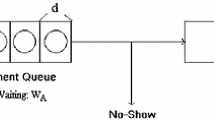Abstract
Appointment systems are widely used to facilitate customers’ access to services in many industries such as healthcare. A number of studies have taken a queueing approach to analyse service systems and facilitate managerial decisions on staffing requirements by assuming independent and stationary customer arrivals. This paper is motivated by the observation that the queueing-based method shows relatively poor performance when customers arrive according to their appointment times. Because customer arrivals are dependent on their appointment times, this study, unlike queueing-based methods, conducts a detailed analysis of appointment-based customer arrivals instead of making steady-state assumptions. We develop a new model that captures the characteristics of appointment-based customer arrivals and computes the probability of transient system states. Through the use of this model, which relaxes stationary and independent assumptions, we propose a heuristic algorithm that determines staffing requirements with aims to minimizing staff-hours while satisfying a target service level. The simulation results show that the proposed method outperforms the queueing-based method.





Similar content being viewed by others
References
Bailey N (1952). A study of queues and appointment systems in hospital outpatient departments with special reference to waiting times. Journal of the Royal Statistical Society 14 (2): 185–199.
Cayirli T and Veral E (2003). Outpatient scheduling in health care: A review of literature. Production and Operations Management 12 (4): 519–549.
Defraeye M and Van Nieuwenhuyse I (2011). Setting staffing levels in systems with time-varying demand: The context of an emergency department. Working Paper.
Green LV, Kolesar PJ and Soares J (2001). Improving the SIPP approach for staffing service systems that have cyclic demands. Operations Research 49 (4): 549–564.
Green LV, Kolesar PJ and Soares J (2003). An improved heuristic for staffing telephone call centers with limited operating hours. Production and Operations Management 12 (1): 46–61.
Green LV, Kolesar PJ and Whitt W (2007). Coping with time-varying demand when setting staffing requirements for a service system. Production and Operations Management 16 (1): 13–39.
Gupta D and Denton B (2008). Appointment scheduling in health care: Challenges and opportunities. IIE Transactions 40 (9): 800–819.
Hassin R and Mendel S (2008). Scheduling arrivals to queues: A single-server model with no-shows. Management Science 54 (3): 565–572.
Ho C and Lau H (1992). Minimizing total cost in scheduling oupatient appointments. Management Science 38 (12): 1750–1764.
Ho C, Lau H and Li J (1994). Introducing variable-interval appointment scheduling rules in service systems. International Journal of Operations and Production Management 15 (6): 59–68.
Hofmann P and Rockart J (1969). Implications of the no-show rate for scheduling OPD appointments. Hospital Progress 50 (8): 35–40.
Ingolfsson A, Akhmetshina E, Budge S, Li Y and Wu X (2007). A survey and experimental comparison of service-level-approximation methods for nonstationary m(t)/m/s(t) queueing systems with exhaustive discipline. INFORMS Journal on Computing 19 (2): 201–214.
Ingolfsson A, Campello F, Wu X and Cabral E (2010). Combining integer programming and the randomization method to schedule employees. European Journal of Operational Research 202 (1): 153–163.
Jablonski R, Clemmons J and Wilson D (1991). Applying business process improvement to the registration process. In Proceedings of the 4th Annual Quest for Quality and Productivity in Health Systems, Washington DC, USA.
Jouini O and Benjaafar S (2010). Queueing systems with appointment-driven arrivals, non-punctual customers, and no-shows. Working Paper.
Littler RA and Whitaker D (1997). Estimating staffing requirements at an airport terminal. Journal of the Operational Research Society 48 (2): 124–131.
Liu L and Liu X (1998). Block appointment systems for outpatient clinics with multiple doctors. Journal of the Operational Research Society 49 (12): 1254–1259.
Min D and Yih Y (2009). A simulation study of registration queue disciplines in an outpatient clinic: A two-stage patient flow model. European Journal of Industrial Engineering 30 (2): 127–145.
Moorthy R and Teo C (2006). Berth management in container terminal: The template design problem. OR Spectrum 28 (4): 495–518.
Muller R and Chatteri G (2002). Analysis of aircraft arrival and departure delay characteristics. In Proceedings of AIAA’s Aircraft Technology, Integration and Operations (ATIO) Technical Forum, Los Angeles, California, USA.
Muthuraman K and Lawley M (2008). A stochastic overbooking model for outpatient clinic scheduling with no-shows. IIE Transactions 40 (9): 820–837.
Robbins T and Medeiros D (2006). Evaluation arrival rate uncertainty in call centers. In Proceedings of the 2006 Winter Simulation Conference, Monterey, California, USA.
Rohleder T and Klassen K (2000). Using client-variance information to improve dynamic appointment scheduling performance. Omega 28 (3): 293–302.
Steckley S, Henderson S and Mehrotra V (2004). Service system planning in the presence of a random arrival rate. Technical Report.
Testik MC, Cochran JK and Runger GC (2004). Adaptive server staffing in the presence of time-varying arrivals: A feed-forward control approach. Journal of the Operational Research Society 55 (3): 233–239.
Acknowledgements
This work was supported by the Hongik University new faculty research support fund.
Author information
Authors and Affiliations
Corresponding author
Rights and permissions
About this article
Cite this article
Chung, K., Min, D. Staffing a service system with appointment-based customer arrivals. J Oper Res Soc 65, 1533–1543 (2014). https://doi.org/10.1057/jors.2013.110
Received:
Accepted:
Published:
Issue Date:
DOI: https://doi.org/10.1057/jors.2013.110




